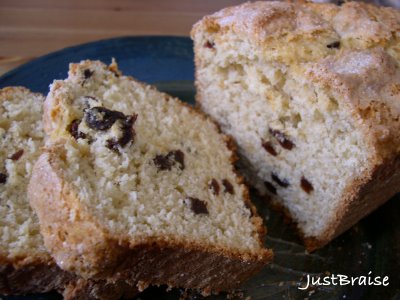Irish Soda Bread

I am not Irish. I never claim to be Irish or wear a “Kiss me I’m Irish” pin on Saint Patrick’s Day. My mother occasionally dyed things green: toast, eggs, mashed potatoes, and Chicago, where I grew up, still dyes the River green for the occasion. Once, in junior high school, for a bake sale on St. Patrick’s Day, I made Rice Krispie Treats. I had perfected the recipe, adding extra marshmallows, creating extremely gooey, delightful snacks and as a special Saint Patrick’s Day festive spike, I dyed the marshmallows green. My fellow students selling them during the lunch period tried one, loved them, and proceeded to tell everyone they had molded, hording them for themselves-- unpaid, I might add.
I do have many Irish friends: Lisa thrives on Saint Patrick’s Day. She celebrates it with more gusto than her own birthday, getting well scuttered, snogging anything that moves. Some attempt to dismiss their Irish-ness, even on their day of celebration. The others I know actually live in Ireland. They are Irish through and through and the three months I lived with them in Scotland they never let me (or any of the Scots) forget it. And I didn’t—in the end I was speaking with more Irish slang than even I could understand.
I do love Irish food. Bangers and rashers are a perfect start to yer mornin’—easy enough even when good and knackered and you can hardly be bothered to lift a finger. I love spuds and cabbage and an Irish cheddar melted over toast is delicious. Guinness is godly, especially if the barkeep has enough dexterity to “paint” a shamrock in the foam. More than anything, I love tea accompanied by a tasty teacake. And soda bread, a Saint Patrick’s Day "tradition", cannot be beat.
One interesting item to note is that the tradition of Soda Bread is not that old. Baking soda made its way to Ireland in the early 1800’s (it wasn’t produced in the United States until the mid-1800’s). Baking soda was found to be a great leavening agent when used in baking and quickly replaced yeast. Traditional Irish Soda Bread is a dry, unsweetened bread made with only four ingredients. Today, many prefer a sweetened Soda “Cake,” adding raisins or even chocolate chips, making it disappear even faster. Any way you cut it, a good Irish treat should be had on this Saint Patrick’s Day.
These recipes come from The Boston Globe’s Andrea Pyenson. I desired a sweeter cake version of the soda bread and made Mary Burke’s recipe. It is full of raisins and includes a little more sugar than Helen Mahoney’s recipe. (I also bulked up the raisins, adding 1-½ cups, soaked in orange juice overnight.) The two recipes are below to satiate two tastes. Chose one, have it with some tea (or a pint) and slainte!
MARY BURKE’S IRISH SODA BREAD
Serving Size= 2 loaves. Active Time= 10 minutes. Inactive time= 40 minutes.
This fine-crumbed bread has a beautifully crunchy crust and just a hint of sweetness.
* 8 Tbl (1 stick) unsalted butter, at room temperature
* 4 cups flour
* 1 cup sugar, plus 1 Tbl for sprinkling
* 4 tsp baking powder
* ¾ tsp baking soda
* pinch of salt
* 1 egg
* 1-½ cups buttermilk
* 1 cup raisins
1) Set the oven at 350 degrees. Butter and flour two 9-by-5-inch loaf pans.
2) In a large bowl, cream the butter with a pastry blender or fork. Add the flour, 1 cup of sugar, baking powder, baking soda, and salt. Mix well with the blender or fork.
3) In another bowl, stir together the egg and buttermilk.
4) Make a well in the flour-butter mixture. Pour in the egg mixture. Mix gently but thoroughly. Stir in raisins.
5) Transfer the dough to the pans, dividing it evenly. Sprinkle the tops with the remaining 1 tablespoon of sugar.
6) Bake for 40 minutes or until the tops are golden and a skewer inserted into the center of the loaves comes out clean.
7) Cool the loaves in the pans on a wire rack for 10 minutes. Turn out of the pans and leave to cool completely.
HELEN MAHONEY’S IRISH SODA BREAD
Serving Size= 1 10-inch loaf. Active Time= 15 minutes. Inactive time= 1 hour
This loaf is slightly drier than Mary Burke's, and not quite as sweet.
* 2 Tbl vinegar
* 2 cups milk
* 4 cups flour
* ½ cup sugar, plus 1 Tbl for sprinkling
* 2 tsp baking powder
* ½ tsp salt
* 2 Tbl unsalted butter, at room temperature
* 1 cup raisins
* 2 tsp caraway seeds (optional)
* 2 Tbl butter, melted
1) Set the oven at 375 degrees. Butter a 10-inch round cake or springform pan.
2) In a small bowl, stir the vinegar into the milk and set aside.
3) In a large bowl, combine the flour, 1/2 cup of sugar, baking powder, baking soda, and salt. Using a pastry blender, cut in the softened butter. Stir in the raisins and caraway seeds, if using.
4) Stir in the milk with a fork just until combined.
5) Transfer the dough to the pan. Using a sharp knife, cut a cross in the middle of the bread. Brush melted butter over the top and sprinkle with the remaining 1 tablespoon sugar.
6) Bake the bread for 10 minutes. Lower the oven temperature to 350 and continue baking for 45 to 50 minutes, or until the top is golden and a skewer inserted in the center of the bread comes out clean.
7) Cool the bread in the pan on a wire rack for 10 minutes. Turn the bread out of the pan and leave to cool completely.




